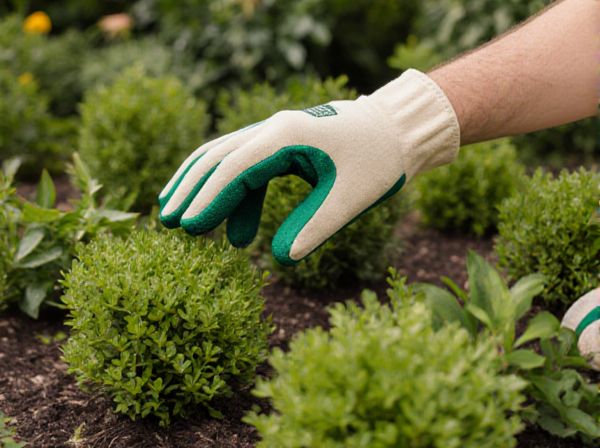
Topiary vs Espalier Illustration
Topiary shapes plants into intricate, three-dimensional forms, creating sculptural garden art with dense foliage and precise cuts. Espalier trains trees or shrubs to grow flat against a support, optimizing space and enhancing fruit production while maintaining a decorative pattern. Both techniques require expert pruning to maintain structure and ensure plant health.
Table of Comparison
| Pruning Method | Topiary | Espalier |
|---|---|---|
| Definition | Shaping plants into ornamental forms by trimming foliage. | Training trees to grow flat against a surface by pruning and tying branches. |
| Primary Use | Decorative garden art and shapes. | Space-efficient fruit tree cultivation and aesthetic design. |
| Plant Types | Evergreens, shrubs (e.g., boxwood, yew). | Fruit trees (e.g., apple, pear). |
| Growth Direction | Three-dimensional shapes. | Two-dimensional, flat against a wall or trellis. |
| Maintenance | Regular trimming for shape retention. | Periodic pruning for branch training and fruiting. |
| Benefits | Aesthetic appeal and garden focal points. | Improved air circulation, sunlight exposure, easier harvesting. |
Understanding Topiary and Espalier: Key Differences
Topiary involves sculpting plants into intricate shapes or geometric forms through precise pruning techniques, creating ornamental designs often used in decorative gardens. Espalier focuses on training trees or shrubs to grow flat against a support structure, such as a wall or trellis, optimizing space and enhancing fruit production. The key difference lies in topiary's emphasis on artistic shaping above ground versus espalier's structural training to maximize growth efficiency and accessibility.
Historical Origins of Topiary and Espalier Techniques
Topiary originated in ancient Roman gardens, where sculpting evergreen shrubs into geometric or fanciful shapes symbolized control over nature and artistic expression. Espalier techniques trace back to medieval Europe, especially France and Italy, where fruit trees were trained against walls to optimize space and improve fruit production. Both practices reflect historical horticultural innovations that combined aesthetics with functional gardening strategies.
Plant Selection: Best Species for Topiary vs Espalier
Evergreen shrubs like boxwood, yew, and holly are ideal for topiary due to their dense foliage and ability to withstand frequent trimming. Espalier favors fruit trees such as apples and pears, along with certain ornamental species like quince and crabapple, which respond well to training against flat surfaces. Selecting the right species ensures optimal growth control and aesthetic appeal for each pruning style.
Essential Tools for Topiary and Espalier Pruning
Essential tools for topiary and espalier pruning include sharp hand pruners, loppers, and specialized hedge shears to achieve precise cuts for shaping. A sturdy pair of bypass pruners is crucial for clean minor cuts, while long-handled tools like extendable hedge shears aid in reaching higher or wider branches. String or wire guides help maintain symmetry and structure, ensuring aesthetically pleasing results in both topiary and espalier designs.
Design Principles: Shaping Plants with Topiary
Topiary involves sculpting plants into clearly defined shapes or geometric forms, emphasizing precision and symmetry to create living art. This method requires consistent pruning to maintain the designed silhouette, often utilizing dense foliage species like boxwood or yew for optimal shape retention. In contrast to espalier, which trains plants flat against a support with an emphasis on maximizing space and fruit production, topiary prioritizes aesthetic design and ornamental value.
Creating Patterns and Forms with Espalier
Espalier techniques sculpt trees by training branches to grow flat against a support, creating intricate geometric patterns or symmetrical fan shapes that maximize space and light exposure. This method emphasizes precise pruning and tying of branches, fostering dense foliage and decorative designs ideal for garden walls or trellises. Unlike topiary's free-form sculpting, espalier delivers structured, architectural forms that enhance both aesthetics and fruit production efficiency.
Maintenance Requirements for Topiary and Espalier
Topiary requires frequent, precise trimming to maintain its sculpted shapes, often demanding skilled labor and regular attention throughout the growing season. Espalier maintenance involves training branches along a framework, necessitating annual pruning to encourage proper growth patterns and structural integrity. While topiary demands consistent shaping, espalier focuses more on directional pruning and support adjustments to sustain its flat, decorative form.
Aesthetic Impact: Garden Style and Visual Appeal
Topiary shapes shrubs into sculptural forms, creating a formal, artistic aesthetic that emphasizes symmetry and bold, geometric designs, making it ideal for classic and ornamental gardens. Espalier trains trees along flat surfaces like walls or fences, offering a linear, elegant look that enhances garden architecture and maximizes space, suited for contemporary and productive garden styles. Both techniques significantly elevate visual appeal by introducing structured greenery, but topiary's three-dimensional presence contrasts with espalier's streamlined, two-dimensional patterns.
Space Utilization: Topiary vs Espalier in Small Gardens
Topiary maximizes vertical space by shaping shrubs into dense, sculptural forms that occupy minimal ground area, ideal for small gardens seeking decorative greenery without crowding. Espalier trains trees flat against walls or fences, effectively doubling usable planting area and creating microclimates that enhance fruit production in limited spaces. Both techniques optimize space utilization by combining aesthetics with functional garden design, but espalier offers greater productivity while topiary excels in ornamental appeal.
Common Challenges and Solutions for Each Technique
Topiary often faces challenges like maintaining precise shapes and dealing with dense foliage that can hinder airflow, which increases the risk of disease; regular trimming and strategic thinning promote healthy growth and preserve intricate designs. Espalier requires careful training to guide branches along a framework, with common issues including uneven growth and structural weakness; solutions involve consistent pruning to encourage balanced development and using sturdy supports for stability. Both techniques benefit from seasonal pruning schedules and monitoring for pests to ensure longevity and aesthetic appeal.
Topiary vs Espalier Infographic

 gardendif.com
gardendif.com